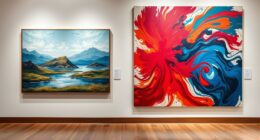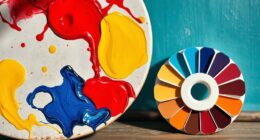To make an interior design mood board, start with a clear vision of your desired style. Gather inspiration from platforms like Pinterest for colors and textures. Use a digital tool like Canva to create your board, taking advantage of customizable templates. Include essential elements such as paint colors, textiles, area rugs, wood finishes, and light fixtures to add depth and ambiance. Focus on composing your layout to guarantee it visually tells your design story. Finally, share your mood board easily with others for collaboration and feedback. There's plenty more to explore for a successful design journey! When creating an interior design mood board for a bedroom, consider incorporating cozy and calming elements like soft bedding, warm lighting, and plush textures. Think about incorporating personal touches, such as family photos or artwork, to make the space feel more inviting and intimate. These bedroom design tips can help you create a retreat that is both aesthetically pleasing and functional for relaxation and rejuvenation.
Key Takeaways
- Define your design style and atmosphere to establish a clear vision before starting the mood board.
- Collect inspiration from platforms like Pinterest to gather colors, textures, and design elements.
- Use a digital tool like Canva or Milanote to create your mood board with customizable templates.
- Focus on composition to ensure a cohesive visual layout that effectively communicates your design story.
- Share your mood board for feedback, using platforms like email or Pinterest for collaboration and visibility control.
Understanding Mood Boards
When diving into the world of interior design, understanding mood boards is crucial for bringing your ideas to life. A mood board serves as a visual representation that captures your design inspiration, allowing you to explore colors, materials, and overall style in a cohesive format.
Whether you're working on a small internet design project or a complete renovation, creating a mood board can clarify your design direction and help prevent costly mistakes. Incorporating elements from different design styles, such as Mid-Century Modern Design, can provide unique inspiration and broaden your creative horizons.
Today, digital mood boards have taken the stage, offering flexibility and the ability to incorporate diverse media, like videos and product links. This means you can easily modify your designs and keep everything organized.
Using platforms like Pinterest and Canva simplifies the process, making it accessible even for those without graphic design skills.
Collaboration is another significant advantage of digital mood boards; you can easily share your board with team members and clients to gather feedback. By establishing a clear color palette and visual direction early in the design process, you set yourself up for success and guarantee that everyone is on the same page.
Tools for Creating Mood Boards

Creating a mood board is easier than ever with the right tools at your disposal. You have a variety of options to help you create stunning digital mood boards for your interior design projects. One of the most recommended tools is Canva, known for its user-friendly interface and drag-and-drop functionality. You can access customizable templates for free, making it perfect for any design need.
Pinterest is another fantastic option. It allows you to collect and organize design inspiration through pinned images, creating a collaborative environment for your ideas. For those seeking advanced features, Adobe Photoshop and Illustrator are great, but they require more graphic design skills and financial investment.
Lastly, consider Milanote. This modern platform offers easy organization and integration of various file types, along with a built-in library of over 3 million free photos.
Here's a quick comparison of some popular tools:
| Tool | Features |
|---|---|
| Canva | User-friendly, drag-and-drop |
| Collaborative, organized images | |
| Photoshop | Advanced, requires skills |
| Illustrator | Professional, costly |
| Milanote | Modern, extensive image library |
Essential Elements to Include

A successful mood board should capture the essence of your design vision by including essential elements that convey texture, color, and style.
Start with paint colors to establish your primary color scheme, setting the mood for the entire space. Next, incorporate textiles and fabric samples to represent various textures, adding depth and tactile appeal to your design.
Area rugs are vital for visually defining spaces, so don't forget to include them to enhance the overall aesthetic.
Wood finishes can convey warmth and style, showcasing your desired material choices and making your mood board feel cohesive.
To bring your vision to life, feature light fixtures that complement your design concept, adding an element of illumination that can dramatically affect the room's ambiance.
Step-by-Step Creation Process

Starting with a clear vision of your desired interior design style and atmosphere lays the groundwork for your mood board. For instance, if you're inspired by the modern farmhouse aesthetic, consider how elements like neutral color palettes and vintage furniture can influence your design decisions.
Begin by defining this vision, which will guide your design decisions. Next, gather inspiration from platforms like Pinterest. Collect images that represent colors, textures, and design elements that resonate with your aesthetic.
Once you've curated your inspiration, it's time to create your mood board. Use a digital tool like Canva for a seamless experience. Start with a blank template or modify an existing one to suit your needs. Upload the images you've gathered, and arrange them on the canvas.
Pay attention to the composition; aim for a cohesive visual layout that tells your design story clearly.
After you've placed your images, take a step back and review your work. This is the moment to refine your mood board. Confirm it accurately reflects your interior design intentions and evokes the atmosphere you aim to create.
Once satisfied, download your mood board for personal use or to share with collaborators. You're now ready to bring your vision to life.
Sharing and Collaboration Options

Sharing your mood board with others opens up new avenues for collaboration and feedback. Once your mood board is ready in design platforms like Canva or Milanote, you can easily share it via email or a direct download link. This allows team members or clients to engage in real-time collaboration, where multiple users can leave feedback and make suggestions directly on the board.
Engaging with professionals through platforms like the Études Architect App can further enhance your collaborative efforts, as it showcases architectural projects and fosters innovative ideas.
Utilizing comment threads within these platforms promotes constructive discussions, helping everyone refine ideas and clarify design elements. If you're using tools like Pinterest, you can share boards publicly or privately, ensuring that your collaborators have easy access while maintaining control over visibility.
Additionally, saving and exporting your mood board as a PDF or image file makes it easily shareable across various platforms and accessible for future reference. This flexibility not only enhances collaboration but also allows for seamless integration of feedback.
Conclusion
Now that you know how to craft an engaging mood board, let your creativity soar! Think of your mood board as a canvas where your design dreams come to life. With the right tools and elements, you'll weave together a visual story that reflects your unique style. So grab your materials, plunge in, and watch as your ideas bloom like flowers in spring. Happy designing, and don't forget to share your masterpiece!









